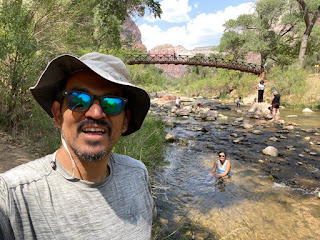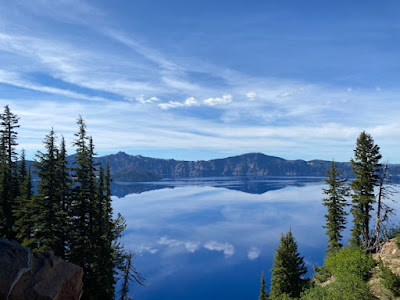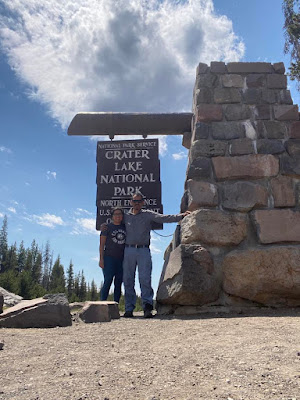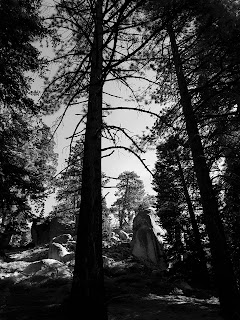Overstimulation: Resting in the Virgin River
By Armando Ortiz
In the heart of Zion National Park, amidst the towering canyons and desert landscapes, I found myself wading in the quiet waters of the Virgin River. As we submerged our bodies in the cool river, I began to reflect on life. It's so easy to get caught up multitasking and doing multiple things at once and how nature offers a welcome respite from the constant electronic overstimulation.
As I rested my body in the waters, I became captivated by the magical beauty surrounding me. I noticed different dragonflies hovering along the river’s edge, some iridescent shimmering in the sunlight, ruby red, blue topaz or pastel yellow. tiny fish began to nibble at my fingers. At that moment I realized that mountains weren’t simply triangular peaks but are also narrow canyons and flat mesas. Floating in the water I realized sandstone can be made up of a spectrum of oranges, with hot pinks and crimson reds bended like a layered velvet cake with hints of tangerine.
In the midst of this sacred place, I was reminded that rivers weren't always freezing cold. In the desert heat of Zion National Park, where temperatures soared to 115 degrees fahrenheit, the river’s 75 degree waters became a cooling sanctuary. Luckily I was not alone to enjoy these waters. Yeny was there with me. Other visitors were enjoying splashing into the waters.
Being overstimulated by nature brings with it a serene experience, and as I moved my arms and legs in the water I wondered about the lives of those that once called this land home. Even more profound were the cottonwood trees lining the river, and watching its branches sway with the wind and its leaves switch from muted green to yellow green like tiny hands waving at everyone there. The cottonwood trees seemed to whisper secrets of the past, leaving me wondering about the lives of those who once called this place home and how they adapted to the environment. What materials did they use to build their homes? Where did they seek shelter and shade? Among the aspen or juniper trees? How did they navigate the intricate maze of the canyons? Could the alpine plateaus have been locations for the hunt? What vision quests did they embark upon?
This is what you experience as you rest in the shallow waters of the Virgin River. It brought forth a flood of questions, eclipsing any answers offered by a search bar. It was both physical and intellectual stimulation that the river evoked, finding moments of peace as I moved my arms and legs through the water.
Resting in the Virgin River was more than just a physical experience. It was an experience of reflection and wonder. It opened my eyes to the magical beauty of nature and its ability to transport us through time and space. We left the river with a greater appreciation for the delicate balance of life and an insatiable curiosity about the past and the untold stories they held.
If you ever find yourself longing for a special connection with nature, and are open to consider history’s mysteries, I encourage you to dip your body in the Virgin River. Embrace the colors, the extreme elements, and listen to the whispers of the past, and let nature become the screen that over-stimulates your senses with its boundless wonders.






















